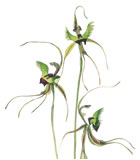
The Western Australian Chronicle and Perth Gazette, 1831




Babette Augustin and children in front of the family farm
- Diary of Babette Augustin
Butterfly Orchid
- Rica Erickson (Botanical Collection)
Sir Norman
Brearley's pilot licence
Handwritten in ink in two columns on both sides of two sheets of foolscap paper and written in a clear, bold hand this second edition of The Western Australian Chronicle and Perth Gazette published on 26 February 1831, is one of the earliest surviving copies of a Western Australia newspaper.
Written and published by William Kernot Shenton every Saturday, it featured copied newspaper items from England, government notices, shipping notes, births and deaths, purchases and sales and was available to anyone for three shillings - an enormous cost at the time and equivalent to two loaves of bread.
The newspaper remained a handwritten publication until the end of April 1831 when the Ruthven iron hand printing press arrived from Hobart, Tasmania.
The only known newspaper to precede it in the colony was The Fremantle Journal and General Advertiser, of which the Battye Library holds edition number 3, published on 27 February 1830.
A common newspaper practice in the early years of the 20th century in Western Australia was the production of a few copies of the first edition printed on cloth in addition to paper copies.
Usually printed on silk or cotton, they are a beautiful and enduring memento of the birth of a newspaper. The most common colours used were pink, blue and cream and the Battye Library has a fine collection of them.
Particularly fine examples are the Camp Chronicle: the Soldiers' Paper, published every Thursday at Midland Junction 1915-1918 (special issue of first edition on blue cloth); the Meekatharra Miner, published every Saturday 1909-1918 (special issues of first edition on pink and cream silk); and the Mount Morgans Miner (only the special cloth issue is held due to the printing plant being destroyed by fire).
(Click on one of the thumbnails above to see a larger image)
Please note: The content on this website is made available for archival purposes and may not meet the State Library of Western Australia's current standards for web accessibility, mobile device compatibility, historical accuracy and cultural sensitivity.